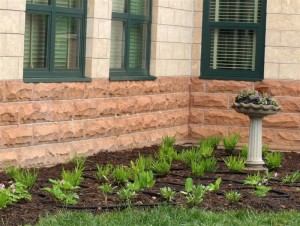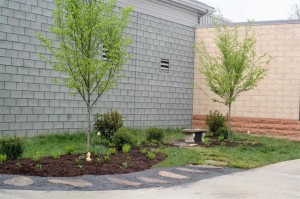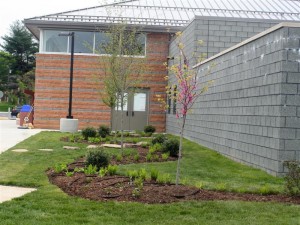Educational Garden Project
SLES’s award-winning conservation garden-landscape was installed by the SLESEF for all to enjoy and learn from. SLES students have used the gardens in their curricular studies as it is composed of native plants that provide important habitats for wildlife, including goldfinches and butterflies. The gardens also reduce rain runoff, pollution, and are a wonderful resource to learn about conservation gardening!
Reflecting the C&O Canal
In 2012, the SLESEF asked the Montgomery County Master Gardener Program for assistance in designing an educational garden and incorporating more green space into the SLES grounds.
Lead landscape designer, Master Gardner Debbie Friedman of Bethesda Garden Design, designed a landscape filled with native plants to evoke a vision of water (with flowing grasses to simulate the water of the canal) and reflect the habitation that surrounds the C&O Canal.
The native Maryland plants incorporated into the design not only resemble the look and feel of the landscape of the historic C&O Canal, but also allow ease of maintenance and minimize use of resources.
Stone steppers were later added to replicate the rocky terrain of the Great Falls area of the C&O Canal and to allow access by students to study the plants and wildlife in the new landscape.
Ms. Friedman was also asked to choose native plants to soften the appearance of the cinder-block walls to the far left and far right of the building. Replacing turf with native plantings not only reduces mowing needs and CO2 emissions, but also decreases rain runoff and provides a natural habitat attracting wildlife.
In 2013, the SLESEF secured a grant from the Montgomery County RainScapes Programto subsidize the sizable cost of the new landscape.
Funds raised by the SLESEF and the SLES PTA (including funds earmarked for the stone steppers, named “Carol’s Way” in honor of a long-time SLES front office secretary) allowed not only completion of Phase I but also allowed additional landscaping to be completed around the new front sign and in the interior courtyards.
Enhancing the Curriculum for SLES Students
One important goal of this project was to help educate SLES students about their environment – from the Chesapeake Bay Watershed in general to the C &O Canal in particular. The plantings, many of which are native to the Chesapeake Bay Wetlands habitat, will support diverse curricular teachings on subjects such as water quality, stormwater management, and wildlife habitats since many of the plants selected will attract birds, butterflies, and other pollinators.
In addition to promoting environmental stewardship, the plantings provide SLES teachers with a renewable resource for hands-on education tailored to each grade level and with a holistic curriculum that links environmental study with science and engineering, mathematics, health education, art, writing, social studies, and history.
The Plantings
Far Left/Near Left Front of Building
Foundation plantings, such as taller shrubs (viburnum, shamrock inkberry hollies, northern bayberry) between existing trees soften concrete walls and a variety of native ornamental grasses (river oats, tussock grass) add movement and interest and represent the flowing water of the canal.
Right of Front Door
The grass “river” continues and evergreen shrubs tie together both sides of the front landscape to provide a cohesive look.
All Front Areas
A variety perennials (such as wild bleeding heart, virginia bluebells, and purple coneflowers) and bulbs (such as daffodils and wood hyacinth) give the area lots of color and all-season interest as well as attract birds, butterflies, and other pollinators.



